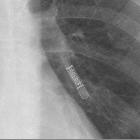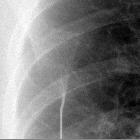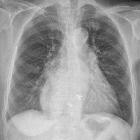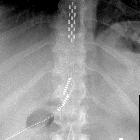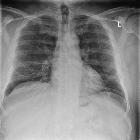Medical devices in the thoracic cavity
Medical devices in the thorax are regularly observed by radiologists when reviewing radiographs and CTs.
Extrathoracic devices
- tubing, clamps, syringes, scissors, lying on or under the patient
- rubber sheets, foam mattresses, clothing, hair braids, nipple piercings, etc. may also be visible
These devices are a common cause of artifacts and may trip the unwary, but in general are recognized for what they are.
The following are more important to be recognized by the radiologist:
- oxygen masks and ventilator support tubing
- temperature and humidity sensor attachments
- ECG electrodes/leads
- external pacemaker-defibrillator (typically seen in a cardiac patient transported by helicopter or ambulance)
- bioreactance leads (e.g. Cheetah Starling SV sensors)
- breast prostheses
- breast tissue expander (used for breast reconstruction)
- cooling blanket
- presternal peritoneal dialysis catheter
Pleural devices
- thoracostomy tubes
- usually placed anterosuperiorly to drain pneumothorax, and posteroinferiorly to drain pleural effusion
- a well-positioned tube should lie between visceral and parietal pleura, and there should not be any kinking
- to check the correct positioning, frequently AP and lateral views are required. Supplemental CT scan may also be performed.
- should not enter the interlobar fissure, else it may be blocked ; tip should not be within the lung parenchyma or subcutaneous tissue
- all drain holes should be in the pleural cavity to ensure effective drainage
- pigtail catheter: used in empyema drainage
- Heimlich valve: it is a one-way valve used for pleural space drainages, which prevents the return of gases or fluids into the pleural space
- plombage: "ping-pong ball" plombage and wax plombage (historically used for tuberculosis, but no longer)
Tracheal, bronchial and esophageal devices
- endotracheal tube
- tip of the tube should be 5 cm +/- 2 cm above the carina (carina is just caudad to the aortic arch, if not clearly visible)
- may wrongly enter right main bronchus, esophagus or even the soft tissues of the neck
- sometimes, a deliberate double-lumen ET tube is used to check differential ventilation of the two lungs
- nasogastric/nasoenteric tube/feeding tube / Dobhoff tube
- esophageal balloons (e.g. Sengstaken-Blakemore tube, Minnesota tube)
- esophageal Doppler probe
- esophageal stents
- esophageal manometer
- esophageal pH probe (seen just above gastro-esophageal junction)
- temperature probe (usually within the oropharynx or esophagus)
- tracheostomy tube
- tracheo-esophageal voice prosthesis
- bronchial stents / tracheobronchial stents (in lung transplant patients or due to obstructing tumors)
- Passy-Muir valve
- endobronchial coils
- endobronchial valves
Vascular devices
- dialysis catheters
- peripherally inserted central catheters (PICC): central portion only
- central venous catheters: central tip ideally positioned at the superior cavoatrial junction and should not enter the right atrium
- temporary non-tunnelled lines: internal jugular and subclavian lines
- tunnelled lines: e.g. Hickman line, Broviac line
- permanent, implantable access line with subcutaneous ports: e.g. Port-A-Cath, Infus-a-Port
- pulmonary artery catheter (Swan-Ganz catheter)
- left atrial catheter
- right atrial line often used postpaediatric cardiac surgery
- thoracic aortic stent
- superior vena caval stent
- superior vena caval filter
- carotid artery clamps
- cannulas of extracorporeal membrane oxygenation devices
- in the right jugular vein (in case of peripheral cannulation), rarely in the left jugular vein
- in case of central cannulation both cannulas are placed directly via central vessels into the atria
Cardiac devices
- sternal wires, plates
- cardiac prosthetic valves, C-ring annuloplasty
- cardiac conduction devices
- pacemakers (e.g. biventricular pacemaker)
- implantable cardiac defibrillators (ICD)
- coronary stents
- circulatory assist devices
- intra-aortic balloon pump (IABP)
- left ventricular assist device (LVAD) (e.g. TandemHeart percutaneous VAD)
- biventricular assist devices
- artificial heart (under development)
- temporary ventricular assist device
- atrial septal occlusion device (e.g. Amplatz closure device)
- left atrial appendage closure devices (e.g. Watchman device)
- epicardial patch
- parachute device
- cardiac restraint device
- insertable cardiac monitoring device (e.g. Reveal LINQ)
- implantable pulmonary artery pressure monitoring device (e.g. CardioMEMS)
Miscellaneous
- embolization coils
- antibiotic spacer
- pericardial drain
- insertable loop recorder
- vertebroplasty-related
- spinal rods, transpedicular screws, disc spacers, interspinous spacers
- gastric band
- reflux management system
- diaphragmatic pacemaker
- surgical clips (e.g. axillary nodal clearance)
- Nuss bar (repair of pectus excavatum)
See also
Siehe auch:
- Fremdmaterial im Röntgenbild des Thorax
- Fremdmaterial Thorax Herz
- Eventrecorder
- Herzohr Okkluder
- Mitraclips
- Herzschrittmacher
- Carillon Mitral Contour System (Cardiac Dimensions)
- Artefakte im Röntgenbild des Thorax
- Ösophagusstents
- intrakardialer Herzschrittmacher
- Plombage
- Intraaortale Ballonpumpe
- Verschlusssystem apikaler Zugang bei TAVI
- Vertebroplastie
- Kontraindikationen für eine MR-Untersuchung
- EKG-Elektroden
- Antirefluxsysteme
- abdominelle Implantate
- left ventricular assist device (LVAD)
- Defibrillator Pads aufklebbare
- EKG-Kabel
- Vagusnervstimulator
- Rückenmarkstimulation
- Koronarstent im Röntgenthorax
- Deep brain stimulators
- Defibrillator Thorax
- abdominelle Implantate und Devices
- pacemakers
und weiter:
- BH im Röntgenbild
- transcatheter aortic valve implantation (TAVI)
- Herzohr Clip
- septal occluder
- left ventricular assist device
- Okkluder
- thorakale Plombage
- Clip Thorax Herz
- MRT unmittelbar postoperativ
- biologische Aortenklappe
- Instrumentenkabel
- Artefakte im Röntgenbild
- Implantate
- RePneu Lung Volume Reduction Coil
- endoskopische Lungenvolumenreduktion
- tragbarer (wearable) Defibrillator
 Assoziationen und Differentialdiagnosen zu thorakale Implantate / Devices:
Assoziationen und Differentialdiagnosen zu thorakale Implantate / Devices:

